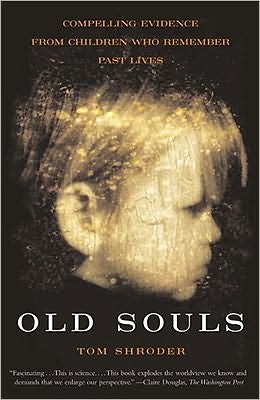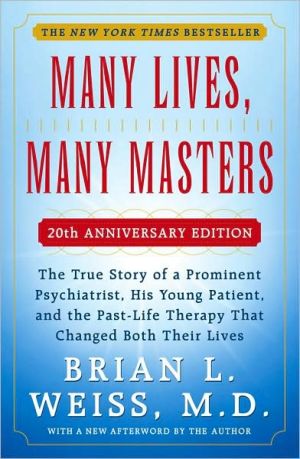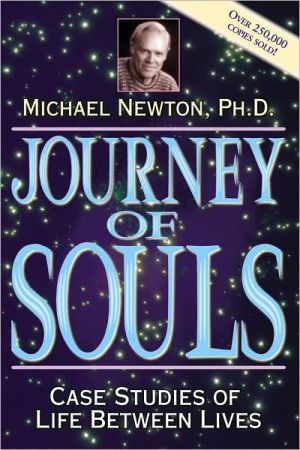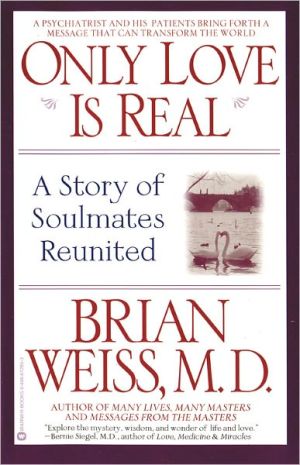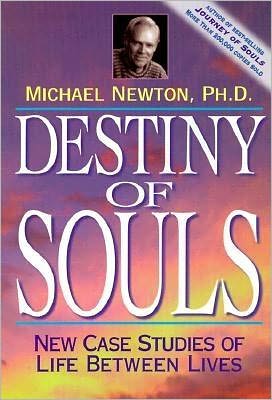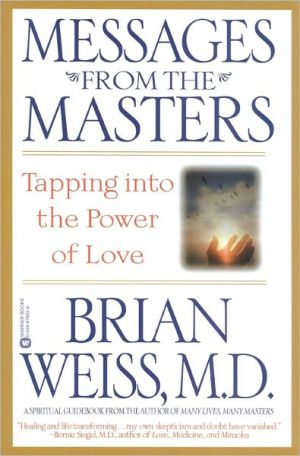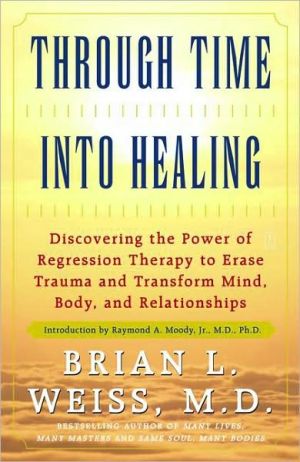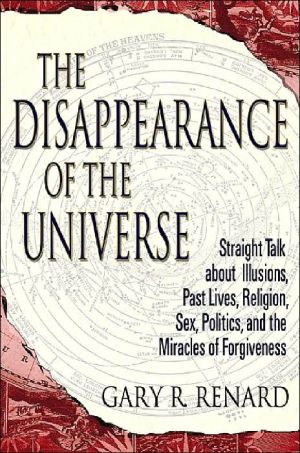Old Souls: Compelling Evidence from Children Who Remember Past Lives
A riveting firsthand account of one man's mission to investigate and document some of the most astonishing untold phenomena of our time\ All across the globe, small children spontaneously speak of previous lives, beg to be taken "home," pine for mothers and husbands and mistresses from another life, and know things that there seems to be no normal way for them to know. From the moment these children can talk, they speak of people and events from the past — not vague stories of centuries ago,...
Search in google:
A riveting firsthand account of one man's mission to investigate and document some of the most astonishing untold phenomena of our time All across the globe, small children spontaneously speak of previous lives, beg to be taken "home," pine for mothers and husbands and mistresses from another life, and know things that there seems to be no normal way for them to know. From the moment these children can talk, they speak of people and events from the past -- not vague stories of centuries ago, but details of specific, identifiable individuals who may have died just months, weeks, or even hours before the birth of the child in question. For thirty-seven years, Dr. Ian Stevenson has traveled the world from Lebanon to suburban Virginia investigating and documenting more than two thousand of these past life memory cases. Now, his essentially unknown work is being brought to the mainstream by Tom Shroder, the first journalist to have the privilege of accompanying Dr. Stevenson in his fieldwork. Shroder follows Stevenson into the lives of children and families touched by this phenomenon, changing from skeptic to believer as he comes face-to-face with concrete evidence he cannot discount in this spellbinding and true story.
Chapter One: The Question\ It is late, nearly lightless. Smoke from a million dung fires hangs in the headlights as the Maruti microbus bangs along the narrow, cratered hardpack that passes for a paved road in the Indian outback. We are still hours away from the hotel, an island of First World comfort in this simmering Third World ocean, and the possibility that we will never get there looms as large as the oncoming truck, absurdly overloaded and undermaintained, shuddering violently as it hurtles toward us dead in the middle of the road. Using every inch of the rutted dirt shoulder, we barely escape. Through the thin tin of the Maruti, I can feel the truck vibrate, smell death in the exhaust pumping from its tailpipe. In escape, there is no relief. We bounce back onto the road's pitted surface and immediately overtake a wooden cart lumbering to the heavy gait of yoked oxen with immense horns. Our driver leans on his horn as he swerves around the cart into a blind curve that I can only pray is not occupied by a bus loaded to the dented metal ceiling with humans and farm animals. I try not to think about the lack of seat belts or the mere half inch of glass and metal that separates the front seat from whatever we plow into — or the Lonely Planet article I read that said fatal accidents were forty times more likely on Indian roads than on American highways. Or the account of a Western traveler who hired a car and driver in northern India, exactly as we have, only to crash head on into a truck, then regain consciousness in agony in a crude hospital, stripped of passport, money belt, and insurance papers. I try not to think about dying ten thousand miles from home, about never seeing my wife and children again, about their lives going on without any trace of me. I try not to think about absolute darkness.\ But even within my bubble of fear, I am aware of the irony. Sitting in the backseat, apparently unconcerned about the two-ton mud-splattered torpedoes racing toward us, is a tall, white-haired man, nearly eighty, who insists that he has compiled enough solid, empirical evidence to demonstrate that physical death is not necessarily the end of me or anyone else.\ His name is Ian Stevenson, and he is a physician and psychiatrist who has been braving roads like this and worse for thirty-seven years to bring back reports of young children who speak of remembering previous lives and provide detailed and accurate information about people who died before they were born, people they say they once were. While I struggle with my fear of dying, he is wrestling with his own fear of annihilation: that his life's work will end, largely ignored by his peers.\ "Why," he asks for the third time since night has fallen, "do mainstream scientists refuse to accept the evidence we have for reincarnation?"\ On this day, and for the past six months, Stevenson has shown me what he means by "evidence." He has permitted me to accompany him on field trips, first to the hills surrounding Beirut and now on a wide swath of India. He has responded to my endless questions and even invited me to participate in the interviews that are the heart of his research. The evidence he is referring to does not come from fashionable New Age sources, past-life readings, or hypnotic regressions during which subjects talk about being a Florentine bride in the sixteenth century or a soldier in the Napoleonic Wars, rendering the kind of details one might garner in an hour's time paging through a few romance novels. The details Stevenson's children recall are far more homely and more specific than those. One remembers being a teenager called Sheila who was hit by a car crossing the road to collect grass for cattle feed, another recalls the life of a young man who died of tuberculosis asking for his brother, a third remembers being a woman waiting for heart surgery in Virginia, trying and failing to call her daughter before the operation she would not survive. It goes on and on: These children supply names of towns and relatives, occupations and relationships, attitudes and emotions that, in hundreds of cases around the world, are unique to a single dead individual, often apparently unknown to their present families. But the fact is, the people the children remember did exist, the memories that the children claim can be checked against real lives and their alleged feats of identification verified — or contradicted — by a variety of witnesses.\ This is what Stevenson has been doing for almost forty years; it is what we have been doing in Lebanon and India: examining records, interviewing witnesses, and measuring the results against possible alternative explanations. I have seen close up, as few others have, how compelling some of these cases can be — and not just factually, but in the emotion visible in the eyes and the voices of the subjects, their families, and the families of the people they claim to have been. I have seen and heard astonishing things, things for which I have no easy explanation.\ Now we are near the end of our last trip together, perhaps the last trip of Stevenson's career. It dawns on me in the noisy chill of the microbus, droning and rattling through the night, that Stevenson's question is not rhetorical. He is asking me, the outsider, the skeptical journalist who has seen what he has to show, to explain. How can scientists, professed to hold no dogma that reasonable evidence cannot overturn, ignore the volumes of reasonable evidence that he has provided?\ I begin to go into some long riff about how, in the absence of any knowledge about the mechanism of the transfer — the means by which personality, identity, and memory can be reassigned from one body to another — it is hard to talk about proof. But then I stop cold. I hear myself rambling, and realize what he is really asking: After all I have seen and heard, do I, at least, believe?\ I, who have always felt mortality in my marrow, who have stared inward but never seen a ripple nor heard a whisper of any life but my own, who have seen people near to me disappear into death with an awesome and unappealable finality and learned in my flesh, where it counts, that the only thing abiding is an unyielding sense of diminishment. What do I think?\ He wants to know. He is asking me. He deserves an answer.\ Copyright © 1999 by Tom Shroder\ Chapter Two: You Only Live Once\ It's a long answer, and it begins ten years before he asks the question, in a small, surprisingly comfy doctor's office just blocks from my home in Miami Beach. The room is dimly lit. Dr. Brian Weiss, chief of psychiatry for Mount Sinai Hospital, is speaking softly in a remarkable voice, a voice that rustles like wind chimes, rises like the smoke from a joss stick — a perfect voice for hypnosis. He is wearing a white coat and spectacles; his great, graying, blow-dried mane engulfs an earnest, open face. He is telling a story:\ In 1982, he hypnotized a young woman. She lay on her back on the couch, eyes closed, hands lightly at her sides, eased into a trance by the doctor's voice and the willingness of her mind, swaddled in a blanket of imaginary white light. He ordered her back to her earliest memories, back to the root of the anxiety that plagued her life.\ Weiss had been treating the woman for acute phobias once or twice a week for eighteen months, but this was only the second attempt at hypnosis. The first session uncovered a significant memory from the age of three — a disturbing sexual encounter with her drunken father — but there had been no improvement in her condition. Weiss found it extraordinary that such a breakthrough would not be accompanied by some alleviation of symptoms. Could there be a memory even further back, buried even deeper in her mind?\ Weiss decided to give her an open suggestion. He made his voice firm and commanding: "Go back to the time from which your symptoms arise."\ In her deep trance she spoke in a hoarse whisper. There were long pauses between her words, as if it were difficult or painful to speak. "I see white steps leading up to a building, a big white building with pillars....I am wearing a long dress, a sack made of rough material. My name is Aronda. I am eighteen...."\ Weiss, uncertain what was happening, scribbled notes. The whisper went on: "I see a marketplace. There are baskets. You carry the baskets on your shoulder. We live in a valley. There is no water. The year is 1863 B.C."\ Before the end of the session, Aronda died, terrified, gasping and choking in a flood.\ This was the turning point for the woman on the couch, Weiss said. Her fears — of choking, of drowning, of the dark — would fall away after that. In the ensuing months, her hoarse whisper ranged through centuries. She would become Johan, who had his throat slit in the Netherlands in 1473; Abby, a servant in nineteenth-century Virginia; Christian, a Welsh sailor; Eric, a German aviator; a boy in the Ukraine of 1758 whose father was executed in prison. In between lives, floating in a shining void, she would become the host for disembodied spirits who revealed the mysteries of eternity. And, said Weiss, she also became well.\ Weiss would write a book about the anonymous woman he called Catherine. Many Lives, Many Masters became an international best-seller and is considered a New Age classic.\ In 1988, with the book buoyantly topping local paperback best-seller lists, I decided to write a story about Weiss for Tropic, the Miami Herald's Sunday magazine, of which I was then editor. What interested me was Weiss himself: He was no New Age flake. At forty-four, he was a Yale Med School graduate and a nationally recognized expert in psychopharmacology, brain chemistry, substance abuse, and Alzheimer's disease. He said that he had waited four years to write his book for fear that his professional peers would ostracize him. Two years after he finally summoned the courage to publish his account, though, his fears had not been realized, at least not publicly.\ Before going to interview him, I called the president of his hospital for comment and got only gushing praise: "Brian Weiss is highly respected, a competent leader in his field." When I asked him if Weiss's reputation had been tainted by the book, he responded with a sharp "No."\ Others concurred. "If anyone else had written the book, I would not have believed it," said a colleague. "But I do because I know Brian Weiss as an astute clinician, researcher, and diagnostician."\ The fact that normally conservative medical people were taking Weiss's ostensibly extravagant claim of evidence for previous lives seriously intrigued me. It didn't persuade me of anything, but it made for a better story.\ When I read his book, the first thing I noticed was a surprising lack of skepticism. Okay, so one of his psychiatric patients had imagined herself to be an Egyptian named Aronda. That, in itself, did not seem to me to merit any further assumption than that she was expressing a fantasy. And yet Weiss was absolutely persuaded. I didn't get it.\ In that first meeting in his office, I made no secret of my puzzlement. I told Weiss that I wanted the opportunity to satisfy my curiosity about his story, and that meant that I would be asking a lot of pointed questions. Weiss responded with a shrug and a self-effacing smile. "The whole field is new," he said. "There are a lot of possible loose ends."\ Sitting behind his desk, his voice hoarse from a round of talk shows in Pittsburgh, where he had spent a sleepless night in an overheated hotel room, Weiss patiently worked through his logic: He had been treating Catherine, a lab technician in his own hospital, for eighteen months. During that time, he had used conventional therapy, and Catherine had never mentioned any belief in the occult or tried to manipulate him in any way. The only unusual thing about her therapy was her lack of progress. So, if Catherine were a con artist, Weiss reasoned, she was an incredibly patient one, for such a fraud would require her faking psychological problems for eighteen months, waiting for Weiss to suggest hypnosis, faking an emotional reexperience of an early childhood trauma in the first session, and only then slipping back into the phony past lives.\ Weiss said that he had had thousands of hours to observe an endless array of patients, to hone his diagnostic ability, his BS meter. With Catherine, he felt sure that he had a patient with symptoms she genuinely wanted to alleviate. She was a simple, honest woman with a commitment to the Roman Catholic faith of her childhood; here was not a schizophrenic or psychotic, no manic-depressive or multiple personality. Her thinking was not delusional.\ Then there was the way Catherine responded to the past lives herself. She seemed uncomfortable with them. They did not square with Catholicism, and she found them somewhat embarrassing. But she was thrilled with the rapid improvement in her condition, so she continued the sessions until she felt that she was cured. There was nothing about her that suggested any interest in using the past-life experiences for anything other than a therapeutic purpose. She hesitantly agreed to sign a release for the book, but she had no monetary stake in it. Even now, he said, when he bumped into her at Mount Sinai, she showed little interest in the metaphysical implications of her experience.\ For those reasons, Weiss believed that Catherine was not crazy or a con artist. What convinced him that she was remembering actual past lives was that the lives themselves were strikingly mundane — a fact that Weiss felt lent credibility that would have instantly evaporated had Catherine appeared as, say, Cleopatra in one life and Madame Curie in another. She was a servant, a leper, a laborer. In her deep trance, she focused on things like the scent of flowers and the glamour of a wedding she was not permitted to attend — everyday things, real-life things. Her memories were at times fairly detailed — in one life, she described the process of churning butter, in another, the preparation of a body for embalming. To Weiss, the descriptions — though far from technically complex — seemed to be beyond Catherine's normal range of knowledge. Once, recently returned from a trip to Chicago, Catherine told him that she had stunned herself on a visit to a museum by spontaneously blurting out corrections to the guide's description of four-thousand-year-old Egyptian artifacts.\ I was impressed with Weiss's sincerity, but not by his evidence. Had he located the museum guide and the guide confirmed Catherine's account, admitting that he had later researched the artifacts in question and found himself wrong and Catherine correct, I might have been impressed. But none of that had happened. And in none of Catherine's past-life memories did she come up with the kind of details that any fan of historical fiction couldn't have manufactured. Catherine did not speak in archaic languages or scribble madly in Sanskrit or even mention the name of a single person who could be proven to have existed.\ "I was so overwhelmed by what was coming out that I didn't really probe for that kind of thing," Weiss responded. "When I did try to steer her, she would often ignore me. This is the kind of thing that would be interesting to investigate. I've only made a small beginning. Catherine is just one case history."\ And not a very convincing one, I decided, the more I considered it. In the session when Catherine remembered the life of Aronda the Egyptian, she used the term "1863 B.C." — "before Christ" — a term that no ancient Egyptian would know, and a translation of the ancient dating system that would require painstaking calculation by an Egyptologist. Furthermore, despite this eerie omniscience displayed as an eighteen-year-old Egyptian, in another lifetime Catherine could not come up with the date because she "can't see a newspaper." I also noticed that according to Weiss's account, Catherine said she was living as a Ukrainian boy at precisely the same date that she later claimed to be a Spanish prostitute.\ None of that shook Weiss's faith: "The totality of the experience," Weiss said, "was such that these inconsistencies only add to its complexity. There is so much we don't know."\ Way too much, I thought.\ While interviewing Weiss, I met one of his patients. A therapist herself, she was a clinical social worker who worked with multiple-personality cases and also did past-life regressions with some of her own clients. She saw Weiss because she believed that dimly remembered traumas from her past were haunting her. Under hypnosis in a session with him, she had taken the elevator of her mind into the basement of the past — and kept going:\ "I saw a lot of darkness — blackness — and I realized that I was blindfolded. Then I saw myself from outside. I was standing on top of a tower, one of those castle towers made of stone. My hands were tied behind my back. I was in my early twenties, and I knew that I was on the side that had lost the battle. Then I felt an excruciating pain in my back. I could feel my teeth gritting and my arms stiff and fists clenching. I was being lanced, I could feel the lance in my back, but I was defiant, I wasn't going to scream. Then I felt myself falling, and felt the water of the moat closing around me. I've always been terrified of heights and drowning. When I came out of it I was still shaken, and I spent a couple days in agony — I couldn't even touch the bones of my face, the pain was so great — but the next morning when I woke up I thought, 'Something's different. Something's very different.'"\ Now she was willing to undergo another hypnotic regression while I watched. She lay down on the carpet in Weiss's office and, under his suggestions, drifted back to another lifetime in which she saw herself hanged in public.\ Once again, the descriptions that she offered of her experience struck me as unremarkable in detail, devoid of archaic vocabulary or knowledge beyond what any contemporary college graduate could produce without research or even hesitation. Watching the woman on the carpet, listening to her speak, what I was witnessing seemed self-evident: a contemporary American free-associating on a medieval theme.\ Maybe, though, I was missing something that could only be found in the subjective experience. I asked Weiss to recommend a hypnotist to guide me through my own regression. I found the process to be relaxing, soothing, and oddly narcissistic, but completely devoid of any sense that forgotten past lives were opening to memory. Instead, I had the clear perception that I was attempting to supply the hypnotist with what she wanted, scenes from a time before I was born. I waited for an image to pop into my mind, and then attempted to embellish it into an appropriate life situation — exactly what I did when I was trying to write a piece of fiction or drifting off to sleep. When I became even more relaxed, more deeply "into" a slightly altered state of consciousness, the images began to come without any conscious effort. But even then, they never carried with them any more weight of authenticity than a garden-variety daydream.\ When I saw the therapist/public-hanging victim again, I related my impressions. Without meaning to, she revealed what I took to be an ulterior motive for believing in her past-life memories:\ "It never made sense to me that we could be here for such a short time, and then...nothing," she told me.\ And who hasn't felt that, felt it with the deepest instinct in their soul? Being into nothingness; light into dark. Current on, current off — it just doesn't seem right. Or, maybe more accurately, it doesn't seem fair.\ Also on Weiss's recommendation, I visited a psychic who specialized in "reading" past lives. Even in the context of reporting the story, I did it as a lark.\ The psychic worked out of an office on the second floor of a Miami Beach shopping center across Route A1A from the Atlantic Ocean. She sat opposite me at her desk, animated, excited still, after all the years, with the prospect of her work. Speaking in a charming delirium, she pointed out signs and portents on astrological charts. "I'm warming up my right brain," she told me. "I'm waiting until I see it."\ And soon she did see, past lives by the handful — I was an alcoholic, drinking away the last of an old Southern family's money after the Civil War; an aging Japanese sage with arthritic hands and students at his feet, a black Jamaican sorceress, an Australian rancher, a German physician. As she talked, the lives filled with lovers and children, struggle and success, landscapes and lifescapes ranging through history, around the globe. My wife, my daughter, I've known them all before, she told me. And I'll know them all again. And again.\ It was wonderful to imagine: never having to say good-bye; the soul unfettered from this claustrophobic constriction of time and circumstance that is our single life, our only life.\ Unfortunately, nothing this woman told me had any resonance whatsoever, no echo, no fading scent of jasmine or sting of gin on the back of my tongue. The lives she sketched belonged to a stranger, or a stranger's imagination. The only thing clear to me was how powerful the urge is to believe, how strong the motivation for self-delusion. I filed the thought away, thinking I might need to refer to it in the future.\ Though I was a little shocked that Weiss had recommended this woman — apparently taking such a parlor game seriously — and thought it might reflect an inadequacy in his BS-detection system after all, I realized that his hypnotic regressions still begged some alternative explanation. Other psychiatrists I interviewed, while not ready to make the conclusions Weiss had made, were still intrigued as well.\ "Those of us who do hypnosis are not all that shocked by Dr. Weiss's book," one told me. "Many have had patients who have gone back to something. I'm not prepared to say it was a previous life. I think we are very interested and very afraid to talk about it."\ A psychologist widely considered an expert in hypnotherapy and multiple-personality disorders said, "I have had a number of patients who have had vivid, emotionally laden experiences that have taken place in the past and had a profound effect in the present. I can't say that these experiences were actual memories of past lives. It is possible that they were fantasy material similar to screen memory — an indirect way of describing a problem. For example, a person who talks about being raped in a previous life may actually be discussing a childhood memory of incest. But there is a purposefulness to the unconscious. Whatever is happening with these past-life memories, I don't believe they are a sham."\ Just recently, this man told me, he had a patient who awoke at 2 A.M. "famished" and very disturbed. She couldn't get back to sleep. When he hypnotized her, he asked her to drift back to the cause of her upset. Suddenly there was a big smile on her face. "Of course," she said. "I was there!"\ She was talking about Kristallnacht — the beginning of the Holocaust in Germany. There had been a lot of news coverage the preceding week on the fiftieth anniversary of the Nazi thugs' night of terror against Jewish homes and businesses.\ "What struck me was that she kept using the word famished, which seemed an unusual word for her. Interestingly, fa-misht is a Yiddish word meaning something like 'all mixed up, bewildered' — a good description of the chaos of Kristallnacht. When I asked her about it, she said she didn't know why she chose that word, that it wasn't in her normal vocabulary. I have to say that I am open to explore this subject. It's my responsibility as a scientist to be open."\ There is an old skeptics' saying: "If you're too open-minded, your brains will fall out." That was the position of some doctors I spoke to, and I tended to agree with them. Dr. Jack Kapchan, a clinical psychologist at the University of Miami with a special interest in parapsychology, for instance was troubled by Weiss's claim to being scientific. Where was the concrete evidence? Where's the thorough background check on the patient?\ "What Weiss has in the book can be explained in naturalistic terms," he said, citing suggestion, fantasy, multiple personalities. In such a case, Kapchan said, it is improper to offer explanations that involve "the paranormal process." What sense does it make to "explain" a relatively simple set of facts — a woman describing a scene from the historical past under hypnosis — by conjuring up a vast array of phenomena, such as a soul, an afterlife, a reintroduction of an old soul into a new body, that have never been detected by any objective measure? That kind of explanation, clearly, should be a last resort, to be used when all other simpler, less-demanding explanations have been ruled out.\ I decided to find the expert's expert, the man who wrote the Encyclopedia Britannica entry on hypnotic past-life regression. This turned out to be Dr. Martin Orne, then a professor of psychiatry at the University of Pennsylvania Medical School, a senior attending psychiatrist at the hospital there, and the editor of The Journal of Clinical and Experimental Hypnosis. He had plenty to say:\ "I always feel like I'm the Grinch who says there is no Christmas, no Santa Claus. The people who promote these things are not malevolent, but they want very badly to believe. People think that if something comes out under hypnosis it is more likely to be true, when in fact the opposite is the case. Hypnosis can create pseudomemories. Reincarnation memories are no different than the cases of people who under hypnosis relate being captured by UFO space aliens and examined aboard the mother ship. These are what I call 'honest liars.' Therapists ask their patient to go back to the cause of a problem. This is something many people find very difficult, and if they can't find a good cause in this lifetime, they'll go back to a previous one — fantasy, of course."\ I remember hanging up the phone in my office feeling that my curiosity had been satisfied. Once again, as I had seen so many times in my career as a journalist, a story that at first appeared to have some fantastic explanation had, under closer examination, been relegated to the realm of the mundane.\ Only recently a classic example of that occurred: the "face" on Mars. For years, after an early flyby of the planet in the 1970s produced a photograph of an area on the surface that appeared to mimic the physiognomy of the human face, an enormous number of pages and Internet computer bytes had been devoted to promoting the idea that this was some kind of monumental architecture that proved the existence of ancient intelligence on Mars. Some saw more than intelligence — they saw divinity.\ Most scientists insisted that the image was a geologic formation and the face nothing more than a trick of shadowing and the human imagination. Others, though, maintained that the scientists throwing cold water on the face idea were thickheaded, biased against anything that upset status-quo concepts of the universe, or part of an immense conspiracy to keep evidence of alien civilization from the public.\ Then, one spring morning, the front page of my newspaper carried the intriguing news that another NASA craft had been directed to fly directly over the "face" and take high-resolution photographs of the area. By midday, the report concluded, we would be able to tap in to the Internet and see for ourselves if the close-up photos revealed clear evidence of alien intelligence.\ I knew the pattern. And I knew that the photographs, when published, would show exactly what they did show: an obviously natural geologic formation, fascinating in its own right as possible evidence of a billion-years-past Martian environment that was surprisingly earthlike, but bitterly disappointing for people longing to see the face of God.\ I saw a similarity in the Weiss story line: "Accomplished psychiatrist and objective scientist supplies convincing proof of reincarnation" was just too easy a way out of the dilemma of mortality. I was now completely satisfied that Weiss had become enchanted with an interesting phenomenon and assumed too quickly that it proved something supernatural when all it truly showed was the amazing richness of the human imagination. (In fact, when I interviewed Weiss again, years after Many Lives, Many Masters, he distanced himself from the idea that regressions proved the reality of reincarnation. What he cared about, he declared, was that whatever these regressions tapped into, even if only the patient's subconscious, had proved to be tremendously helpful in therapy. He had seen problems resistant to all other kinds of treatment clear up almost instantaneously after dramatic regressions. I asked him if he had done any clinical studies to verify his impression that regression therapy got such dramatic results. He hadn't, he said, but he wished that somebody would.)\ Meanwhile, until another Catherine surfaced who could decode the Egyptian hieroglyphics without benefit of even a high school diploma, say, or perhaps tell what a Boston widow whispered in her son's ear on her deathbed in 1947 — and have that son confirm its accuracy and swear that he had never told a living soul — I was willing to call it a day on the evidence for the reincarnation front.\ Except...\ I came across an article about a Dr. Ian Stevenson, identified as the Carlson Professor of Psychiatry at the University of Virginia Medical School, who had been investigating reports of past-life memories from a very different source: spontaneous, waking memories experienced by very small children, no hypnosis involved. These accounts often included names, addresses, and intimate details from lives that the children had no apparent way of knowing about. Surviving family members could be located and the child's purported memories checked against reality. In many cases, according to Stevenson's analysis, the memories passed the reality test fairly persuasively.\ What astonished me was that Stevenson wasn't claiming to have investigated just a handful of such cases, but hundreds of them — more than two thousand, in fact, from all over the world. My first thought, I confess, was that perhaps this was some kind of delusional wacko who also had a drawer full of fragments of the true cross as well as a radio that communicated directly with a race of blood-red dwarves on Io, the fifth moon of Jupiter. But upon reading further, I saw that this was clearly not the case. I found a quote from a 1975 article in no less than The Journal of the American Medical Association stating that Stevenson "had collected cases in which the evidence is difficult to explain on any other grounds [besides reincarnation]."\ The JAMA article also cited a book in which Stevenson had compiled his cases. But although I visited a couple of bookstores and found many books on hypnotic regression and other related topics, I encountered nothing from Stevenson. And while the public library listed several volumes by Stevenson, I could locate only one. I took it home and read it. Its academic style made it difficult to follow, reminding me of the eye-crossing effort it took to read some of my graduate-level college anthropology texts. It proved worth the effort: The cases were compelling, even astonishing, and I was impressed by the apparent evenhandedness and thoughtfulness of Stevenson's investigation. He was after precisely the kind of details that Weiss's case sorely lacked; he sought statements that were concrete, specific, and verifiable about a previous life, things that the subject could not have had any way of knowing normally.\ Time and again, according to his reports, he had found them.\ How in the world, I wondered, could I have never before heard of this man's work? How was it possible that a rather flimsy case of hypnotic regression was the basis for a best-seller, while hundreds of cases of the spontaneous production of verifiable memories took a day at the library to discover?\ And, finally, I wondered this: Why was I writing about Brian Weiss and not Ian Stevenson?\ It would take a decade to set that last one right.\ Copyright © 1999 by Tom Shroder
Contents Part I: Prologue -- Children Who Remember Previous Lives Chapter 1: The Question Chapter 2: You Only Live Once Chapter 3: The Man Behind the Curtain Part II: Beirut -- Children of War Chapter 4: The Book of Daniel Chapter 5: Speed Kills Chapter 6: The Love of Her Lives Chapter 7: The Heretic Chapter 8: In the Name of the Family Chapter 9: New Jersey Is a State of Mind Chapter 10: To Stop a Train Chapter 11: The Last Easy Answer Part III: India -- Children of Poverty Chapter 12: The Milkman Chapter 13: City of Glass and Glamour Chapter 14: Marked for Life Chapter 15: Sumitra Doesn't Live Here Anymore Part IV: The United States -- Children Next Door Chapter 16: A Land Called Dixie Chapter 17: The Edge of Science Chapter 18: Chrysalis Acknowledgments Selected Bibliography
